
eXtensions
|
G5 PowerPC: Minimalist by Design |

In the interviews I run as part of an English course, one of my students asked, "Why do you like Macintosh computers and BMW motorcycles": a good question for an engineer. My reply: "Design." I expanded with "Good engineering" and, particularly with the Mac, "Integration."
The design aspect of Macs has come to the fore in the last few years -- particularly since the first iMac. Jonathon Ives, who heads the Cupertino design team, has been highly praised. The range includes iBook (now with the G4 chip), PowerBook, iMac (with the swivelling plasma screens), eMac, G4, XServer and RAID arrays. A close look shows just how well-designed and -made they are.
When the long-awaited G5 computers were released performance levels were upped considerably. What was striking, in the pictures I saw, was how simple the G5 looked from the outside, even compared with the smooth exterior of the G4; and how well everything had been placed inside.
Although some G5s had appeared in Bangkok's stores by about September, staring at the case for a few minutes or looking at a screen display, is not enough. When the editor of Database, e-mailed me and asked, ". . . are you interested?" my reply was a simple, "You bet." I collected the machine from the Maccenter offices on the Friday before APEC, and had several days free.
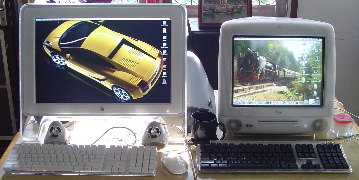 The G5 I had at my disposal was the single processor, 1.8GHz PowerPC with 512MB of memory and a hard disk of 160GB with OSX version 10.2.7 installed. This was an interim version of OSX, specifically for the G5 as its 64-bit processor handles tasks differently. I also managed to borrow a 20-inch Cinema Display.
The G5 I had at my disposal was the single processor, 1.8GHz PowerPC with 512MB of memory and a hard disk of 160GB with OSX version 10.2.7 installed. This was an interim version of OSX, specifically for the G5 as its 64-bit processor handles tasks differently. I also managed to borrow a 20-inch Cinema Display.
The G5 looks right and if you run your hands over it, feels right too. As in all of the best design, everything is in the right place and nothing is overdone.
I ran Apple system Profiler and noted -- and this makes a big difference -- a Bus speed of 900MHz. The office G4 has a bus spped of 133MHz and the iMac 100MHz. I also saw that there were eight memory slots. Six of these were free and there was a paltry 512MB of memory installed. The machine is capable of carrying 8GB of memory (up from 4GMB of the G4). The memory size would make a major difference for those using graphics applications.
On the outside, the case is of clean aluminium. The sides are smooth while front and back have a cheese-grater appearance. In keeping with the minimalist aesthetic, there is almost nothing to disturb the lines on front or sides, with important ports and connectors hidden at the back. The front has merely an on/off button, a power light, and one each of the ports most-used: headphone jack, USB and Firewire. There is also a flap near the top, which conceals the DVD installation.
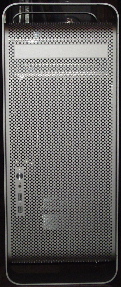
|
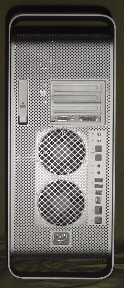
|

|
The rear has a larger array of these same ports, plus telephone input, Ethernet connector and video link. Firewire ports are both 400 and 800MB.
While the G4 has the logic board on the door, which opened flat, the G5 logic board placement is at the back of the case, behind fans, the hard disk and the chip housings. I counted eight fans in the machine I had. There are nine in a dual-chip installation. The single chip installation is contained in an aluminium box to the right. With a dual installation, there are two. I was trying to think what was so different about the inside of the G5. My assistant concluded that it had none of the spaghetti-like wiring of a PC. I noted also that it is considerably cleaner than a G4.
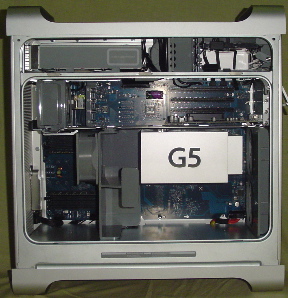
|

|
Instead of the door, the G5 has a flap, normally held shut by a lockable lever. When it is removed (there are diagrams of component removal on its interior face), there is a transparent plastic cover that can be folded down or removed entirely while working.
The white mouse was identical to those I have already, but there were some changes to the keyboard (also white). While former keyboards had two USB ports -- to the left and right -- the new location is at the rear, either side of the power wire. The whole is thinner. The base has also been redesigned: the flap to raise the level is no longer needed.
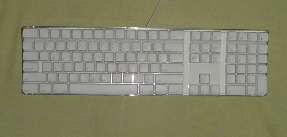
|

|
A minor problem occurred when my assistant was setting up by himself. The plug in the box was one of the old, heavy, square British three-pin plugs which he had never seen before. The machine had been shipped from Malaysia, so that may be the reason. I used a spare.
The G5 came, as expected, with software already installed. After entering Internet connection details, we were online within minutes. I also took the opportunity to set up a local network, using a crossover Ethernet cable. This was really simple and helped greatly in transfer of files and installation of software.
Locally, I have seen a G5 to the same specifications priced at just under 107,000 baht, with the 1.6GHz G5 at 89,900 and the dual-processor 2GHz machine at 133,500. These Macs can be placed between high-end PCs and Unix machines, such as Sun or Silicon Graphics. I consider them better designed both in terms of hardware and operating system. There are still some 1.25GHZ G4s available for 61,500 baht.
A 20" Cinema Display is 54,500 with the smaller 17" Studio Display at 28,750 and the larger 23" display at 86,500. To put this into persective, a 34" plasma screen TV will set you back about 249,000 baht at current prices although these prices are coming down.
Late at the end of the first day of running the G5, I spent some time watching Lord of the Rings: the cinema display, plus the plug-in Harmon-Kardon Creature speakers made this a far better experience than the DVD player and television I normally use.
Note: Between the time the first article was printed and this one, Apple revised the G5 range. The 1.8 GHz PowerPC reviewed here was replaced with a 1.8GHz dual-processor computer. The 2 GHZ machine is also available along with a 1.6GHz single processor G5.
See also Part 2, G5 PowerPC: Maximisation in Use.
For further information, e-mail to Graham K. Rogers.
Back to
eXtensions
Back to homepage